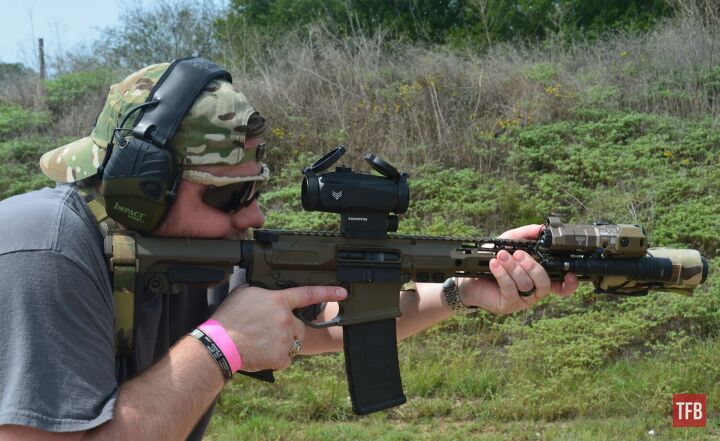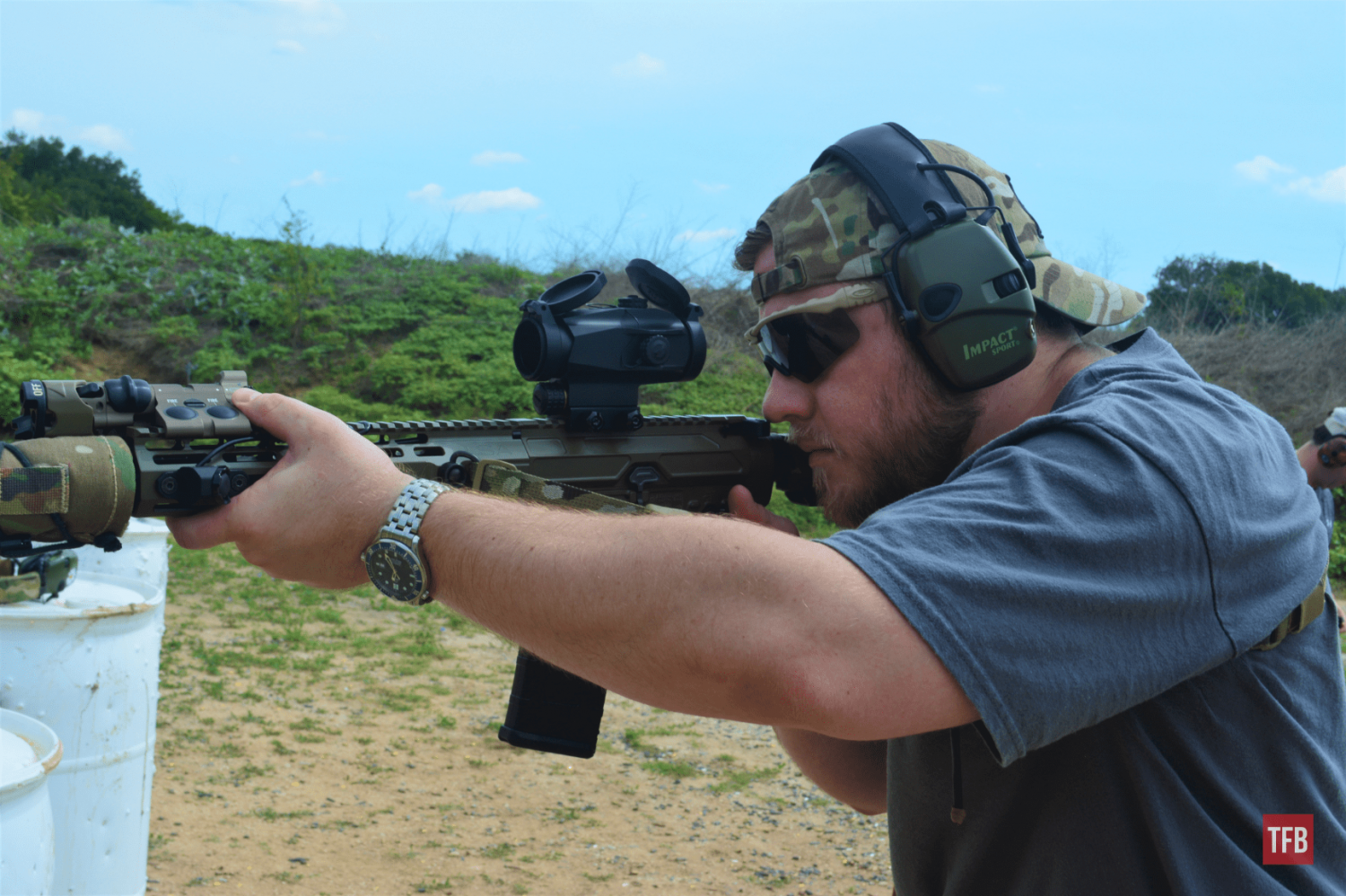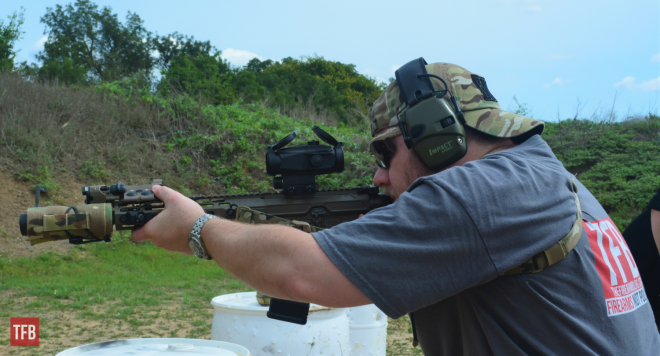Swampfox Optics is a relative newcomer to the world of firearms glass. They recently turned two years old, having been founded on Independence Day in 2018. Students of American history will already have observed that their link to the founding of the United States doesn’t simply coincide with shared birthdays. The company’s name hearkens back to one of America’s first warfighting heroes, Francis Marion. Marion earned his “Swamp Fox” nickname during the American Revolutionary War, in which he served as a Continental Army officer. The name came about due to Marion’s expertise in irregular warfare and guerilla tactics, which he had learned from Cherokee fighters during the French and Indian War. His unusual (for the time) methods proved highly effective against Redcoat forces, and repeatedly served to frustrate the British. This caused the Brits to send Lieutenant Colonel Banastre Tarleton on a special mission to hunt down the wily American. Marion led his small band on a 26-mile evasive maneuver, which allowed them to slip away from Tarleton’s men by escaping through a system of swamp trails. Then resigned to his failure, Tarleton is reported to have cursed, “As for this damned old fox, the Devil himself could not catch him.” Thus the legend of the “Swamp Fox” was born. Today, Swampfox Optics draws inspiration and a sort of spiritual descendancy from Marion.

Swampfox Optics’ branding includes plenty of homage and references to the American Revolution.
Swampfox makes a variety of optics. From several dot sights, long-range riflescopes, two LPVO models, and their prism scopes, they cover a wide range of potential applications. Following my reporting of their recent 3x prism scope release, they got in touch with TFB to see if we would test out both of their prism models, the Blade and the Trihawk. I agreed, and they loaned me a demo unit of each version. The units were carefully examined, and then for testing were affixed in turn to my personal Lone Star Armory AR pistol, which normally bears an Aimpoint T-2 red dot on a Unity Tactical FAST mount. I also have experience with a spectrum of other red dots, LPVOs, and prism scopes including the 4x ACOG that I used primarily during my time as a US Army infantryman, with the M68 CCO (or Close Combat Optic, an Aimpoint CompM2) having been secondary. Prism scopes in general offer an interesting mix of features and pro/con tradeoffs versus the other optics types listed above. Below I will highlight the particulars of Swampfox’s Blade and Trihawk prisms, sharing my experience with and thoughts about them. As always, bear in mind that any gear review necessarily incorporates shooter preference, and your mileage may vary. You might enjoy aspects I didn’t, or dislike some elements I see as positive. What I hope to accomplish in this guide is to provide you with a frame of reference off of which to base your own, but due largely to the personal preferences that always exist, I encourage people to go out and try gear for themselves. If you haven’t yet gotten your hands on these scopes and are curious about the perspective of someone who has, we’ll start with the Blade.

The Blade 1×25 prism scope.
The Blade is Swampfox’s 1x prism scope. Offered in either red or green illuminated versions, it carries a $289 MSRP and runs for approximately 3000 hours on a CR123 battery. With its integrated Picatinny mount, it measures about four inches long by three inches tall and two and a half inches wide. The Blade comes with a pair of flip-up lens covers and a honeycomb killflash that threads into the housing in front of the objective lens. The official product description reads:
Blade is the mission-driven 1x prism scope dedicated for home defense and law enforcement. Blade’s revolutionary Bullet Rise Compensating reticle compensates for optic height over bore at just 5, 10, and 15 yards when mounted on an AR-15. Available with red or green illumination, Blade’s etched reticle appears black when illumination is off. Shake ‘N Wake motion-sensing auto on/off saves battery life and is perfect for home defense. Blade is an excellent choice for shooters with astigmatism who have issues with dot sights. When you need speed and precision at in-your-face distances, trust the Blade.

The Trihawk 3×30 prism scope.
Moving up in magnification and up to a $329 MSRP, the Trihawk is the fixed 3x model of Swampfox’s prism scope. It also comes with either red or green illumination, but given the magnification, they have also opted to offer either a BDC reticle or their MOA version, with the BDC designed to be compatible with either 5.56 or .308 rounds optimized for a 50/200 yard zero. The MOA ladder provides 40 MOA of vertical holds in 4 MOA increments for shooters who want to do the math with their particular rifle. The Trihawk’s dimensions measure roughly a half-inch longer and taller than its 1x cousin, with comparable width. It tacks on a couple of ounces for a 15.4oz total, and shares the Blade’s 3000-hour advertised battery life on the same single CR123 battery. Swampfox’s official product description boasts:
Trihawk is the 3x prism scope featuring a super wide, true ten-degree field of view. Looking through Trihawk, you’ll see a 52ft field of view from edge to edge at 100 yards. Yet Trihawk still offers greater eye relief than comparable prism scopes from other brands. Trihawk’s Trident reticle is great for fast acquisition up close while also providing capability for medium range engagements using either a 5.56/.308 BDC or MOA ladder. Choose from red or green glass etched “Shake ‘N Wake” reticle illumination. If you are looking for a tough, compact, fixed power scope to do it all, look through a Trihawk- you’ll be impressed by what you see.

My personal Lone Star Armory AR wearing the Blade for range testing…

… followed by the Trihawk, to put it through its paces as well.
Both before and after my range testing session, I spent a good amount of time going over both optics at home. Upon unboxing each, I noted that they seemed solidly built with their aluminum housings and integrated mounts. Target acquisition felt reasonably fast and easy with both reticles, either while illuminated or not depending on a variety of lighting conditions. The adjustment turret and battery caps had good knurling and a nice tactile feel. I liked that the cap tethers seemed strong, although I did note that the excess length on the windage/elevation caps’ tether tended to cause it to bind up against the housing a bit when rotating the caps on and off. Turret adjustment clicks could be positively heard and felt with no issues. Due to their size and shape, the hexagonal nuts securing the Picatinny mounting interface can be cranked down pretty tightly even without tools, if need be.

With “ready up”-style drills, I found both of the Swampfox reticles to be quick and easy to get on target.
It was nice to have flip caps and a killflash included for each optic, though both sets of caps turned out to be a bit on the loose side and popped off of the lenses too easily for my liking. It’s not hard to accidentally send a cap flying when you only intend to open it. Were I to own one of these scopes, I’d likely opt to toss them aside in a parts box and leave the lenses uncovered for this reason. Employing a cap on the rear of the unit also interferes with rotating the bezel to adjust the eyepiece diopter, should you need to fine-tune it. In addition to these common characteristics, the Trihawk had a unique point of note not shared by the Blade. Although it’s not uncommon to encounter eye relief acclimation needs with magnified optics, I found the eye relief to be even shorter on the Trihawk than the 2.36″ advertised, by nearly a full inch.

The Blade’s reticle has an interesting bullet rise design. Swampfox recommends that at close-in distances of 5/10/15 yards, you should use the bottom of the circle, the dot below the chevron, and the bottom of the chevron’s arrow, respectively. They suggest a 50/200 zero for the chevron’s tip.
Range testing was conducted under full daylight in an outdoor bay. Each model was no issue to zero at 50m, familiarity firing at various points inside of that distance went fine (unfortunately I didn’t have a longer range available that day), and target acquisition still felt as easy as it had at home. One of Swampfox’s big selling points with the Trihawk, to which I paid attention in testing, is its ten-degree field of view. I’ve never previously noted a deficiency when using other optics with narrower FOV specs, like ACOGs, but if you’re looking for a wider field, the Trihawk does have it. While my impressions were generally good with both scopes on the range and during home testing, apart from the few minor irritants mentioned above, there were some more appreciable downsides worth addressing as well. The most glaring was under illumination. Both the Blade and the Trihawk produced a surprisingly bright shadow reticle off of the actual reticle itself, unless the brightness setting was dimmed dramatically. If I chose a brightness level that was almost not enough to see in ambient conditions, the secondary glow wouldn’t show up, but even just one more level up would create a stark and potentially distracting reflection inside of the glass. This “phantom reticle” effect that I wasn’t crazy about might not bother you, but it’s worth mentioning.

The Trihawk comes in two reticle versions in either red or green flavors: MOA (top, shown here in red) and BDC (bottom, shown in green).
This also tended to cause a significant bleed-over to the outer rim of the viewing window, so that the housing’s edge would glow unusually brightly from the internal reflection. Now don’t get me wrong, I know that this effect is not unique to Swampfox or to prism scopes. With most illuminated optics, if you crank up the brightness to their higher levels, you can create some of that bloom. What struck me, in this case, was just how severe it became at only slightly than optimal brightness levels – definitely more so than has been the case with moderate- to higher-dollar optics I’ve used. It was also notable that it wasn’t just the reticles themselves that bloomed, but a fully secondary reticle reflection was created on the glass, which I found to be decidedly more distracting than, for example, an expanded Aimpoint dot or a pixelated Eotech reticle from over-brightness. Additionally, in some of Swampfox’s marketing, they advertise “distortion free edge to edge”, but I found this to be inaccurate. Toward the edges of the viewing window, I did observe a bit of distortion on both models. It wasn’t enough to interfere with the reticle itself, but it was there. Ultimately, for me, these factors do prevent the Blade and Trihawk from punching above their weight in terms of performance for the money. Happily, though, they aren’t so intense as to make either optic unshootable.

My reticle photography skills aren’t perfect, but hopefully, these images help illustrate the sort of “phantom reticle” effect I observed, with the edge overglow/bloom issues as referenced above. These look predominately similar to what I saw with the naked eye.
I think the company definitely deserves some additional credit here. After completing testing and noting these issues, I reached out to Swampfox to discuss my findings with them. I wanted to ensure that they were given an unbiased fair shake, and that you would be provided a complete picture of the story on these prism scopes. Upon learning of my concerns, Swampfox immediately retrieved the exact Trihawk sample that I had tested (since I was done borrowing the optics for this review and had already shipped them back) to examine it. Respectably, they came back and readily conceded that what I had observed was legitimate. In their response email, their rep told me,
“I really appreciate you bringing this to my attention. Given that we are a young company with all new products, growing pains are to be expected with our early production runs. You had received a Trihawk from our very first run. We move quickly on feedback from our customers and ensure we are continuously improving so I always want aggressive feedback. That all being said, I did not look at the sample Trihawk you sent me until I saw your email. Upon inspection, I am absolutely seeing the distortion and phantom glow which although may be slight, they are not markers of our scope quality and completely outside our accepted tolerance level. I am severely disappointed that this unit made its way to any customer, let alone having it be your first experience with our products.”

When I came across this promotional photo on Swampfox’s website, I could only think of the quote from the “13 Hours” film: “You gonna fight the Holy War in your shorts? Strong move.”
So what’s my verdict? For the price point, I think these are viable options. Swampfox has generally done well in offering some nice features and elements at a relatively manageable cost. The reticles are nice, the glass isn’t bad for the money, the construction seems fine, and overall both models appear to stack up decently against their competitors in the budget optics category. When you compare them to other manufacturers that charge more, do they start to leave a bit to be desired? Yes, at least for me, they do. But honestly, I’d say that’s okay. Why? I think it’s essentially a question of advertising hype versus real-world execution. Tons of gear companies’ marketing departments are going to try to make you think their products outperform Special Forces Navy SEAL Ranger Recon SWAT requirements for way less than the competition’s price. Of course, in actuality, that’s rarely true and more often than not, you get what you pay for. So in the case of Swampfox and their prism scopes, I think it comes down to expectation management. It boils down to getting your money’s worth, and your application – or the basic question of suitability. Do these scopes suit a Nemo Arms or Knight’s Armament gun? Probably not. But mate one to something like a Springfield Saint or Ruger AR-556, and that pairing will start to make more sense.

Have you tried a Blade or Trihawk? If so, how was your experience with these prism scopes? Let us know in the comments.
When I read and watched all the marketing material they’d put out, it seemed like they were trying to punch far above the weight indicated by these optics’ price tags. It sounded like they’d intended to build Aimpoint, Eotech, and Trijicon killers at a budget price, and if that’s the metric by which you attempt to judge these optics, it’s not truly a fair comparison. Sub-$350 is a price point solidly in the budget optics category. For this reason, compare them to other budget optics, and I think you’ll be pleased with the result. Would I prefer to use one of these if I had to go back to Afghanistan or defend my family’s lives against an intruder? Probably not. But do I think they still have good value-for-money to offer, do I think they belong both in the wallet-friendly area of the market and in your consideration set for non-life-dependent shooting? Absolutely. Most of what they need to do, they sincerely do well, and as long as you know what you’re dealing with, the drawbacks are not insurmountable. Best of all, they won’t break the bank! So if money is tight, you have astigmatism, or if you just own a casual plinker/range toy for which you can’t justify dropping a lot of cash on premium-tier optics, definitely check out Swampfox’s Blade and Trihawk. For their niche, the value proposition is there. See you at the range!
 Your Privacy Choices
Your Privacy Choices
